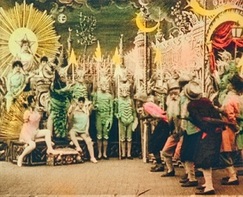A- | A group of astronomers go on an expedition to the moon. Directed by George Melies Initial Review by Shane Setnor |

With A Trip to the Moon, I wonder if the original viewers were even able to keep up with the story. We all get it: It’s a bunch of smart scientist types who travel to the moon, take a dang nap for some reason, fight some aliens and bring one home and parade it. (Colonialism FTW!) This brainy neurologist says yeah, people probably got it because of Jules Verne introducing those ideas into their heads: (http://brainknowsbetter.com/news/2014/2/21/georges-melies-a-trip-to-the-moon-reveals-the-psychology-of-film) The author mentions how when movies are shown to people living in remote areas of Turkey, they don’t necessarily understand all of the plot or what is going on. But if they’ve been introduced to the concepts being shown, they follow along just fine. So suffice to say, this film was well-received in its day. (Speaking of well-received, it was so popular that Thomas Edison stole it, removed director George Melies’s name and illegally shared it across the USA. Thomas Edison is the original Napster.)
Ultimately, we can’t really evaluate the plot here. It’s simple by necessity. It could have added some clarifying dialogue (I assume that was invented by then), but it isn’t necessary for such a simple plot. I like that the viewer had to figure out what was going on. I think it added to what we were seeing. However, I really have no idea if this was remotely intentional or not. I do know that it was original to put this story on film.
I think we can take a second to appreciate the special effects here. There’s really nothing special about the moon men disappearing when being struck by an umbrella. Hell, we probably all did similar effects as kids when making home movies. Even though I knew what the trick was, Melies pulls it off with deft editing (and smoke bombs) that I don’t even care. I’d rather watch those special effects, which actually feel tangible, than the CGI in Charlie’s Angels or Fast and Furious, which never seem real to me.
We know a lot of old films are unremarkable. A Man Shaving His Face isn’t something I eagerly want to see pop up on Netflix, but I’m sure it was revolutionary at the time. But with a Trip to the Moon it’s how the movie looks and feels. Melies gives us something with style that is a pleasure to watch. Even in black and white, you can appreciate the layering and slick artistry that pops off of the screen. The color version is even more interesting to watch. (It’s also interesting that each frame was hand-painted. This blows my mind that 200 people did that.) Melies can’t provide the viewer with realistic depictions of rockets or the moon, so he embraced that gave the viewer highly stylized version instead. It’s amazing that Melies was able to do so much more to add to the film visually than Linklater did in the train wreck Waking Life. (Fun game: type “awful animated movie about philosophy”)
I’m certain some purists might take offense to the addition of an electronic musician doing the score to a movie over 100 years old, but I think Air hits a homerun here. The backing music always matches the tone and pace of the scenes. The eerie noises in the soundtrack add to the mysticism of the moon men. The steady beat pulls you further into the workers swinging hammers. Really, there’s no reason for a scene of people hammering sheet metal to be interesting, but the visual and auditory rhythms kept my eyes on the screen. And the final track gives us a celebratory feeling and leaves the viewer feeling like something amazing just happened.
Ultimately, this film left me feeling like a child. Like I was watching something for the first time. It’s a great feeling to get back.
A
Original review by Shane.
 RSS Feed
RSS Feed